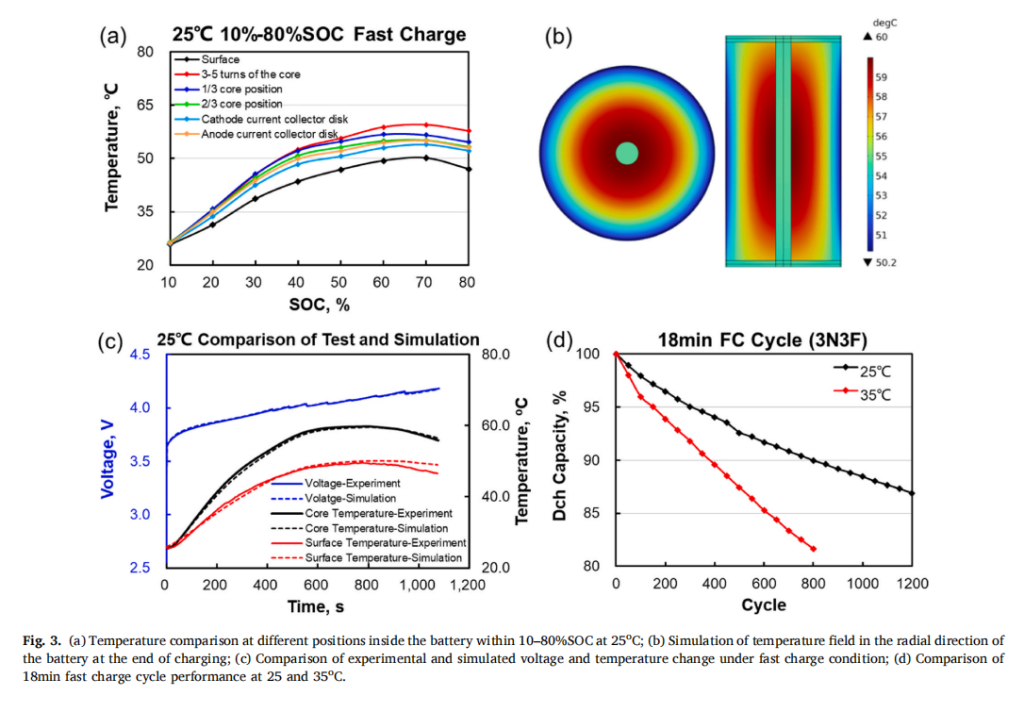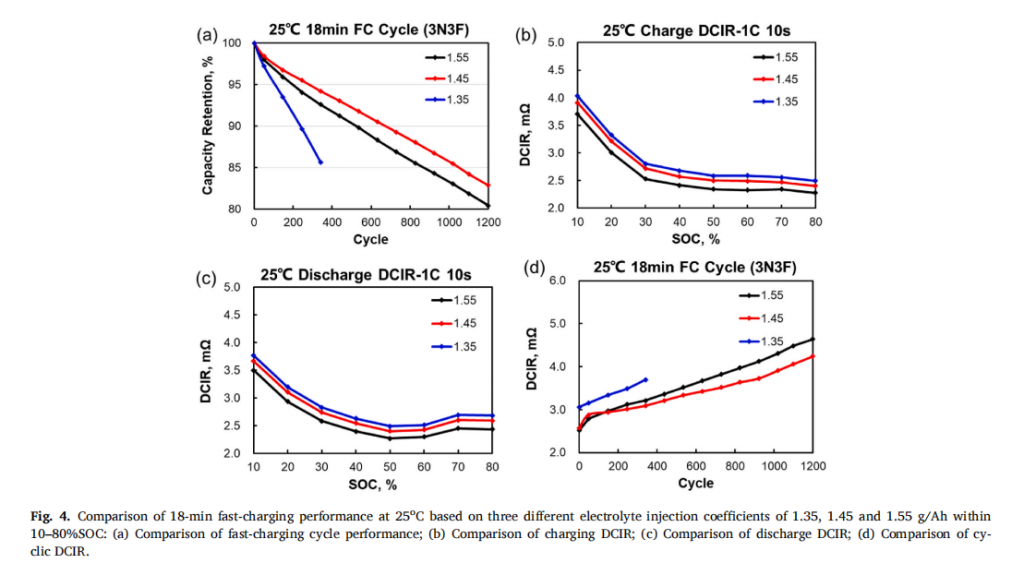The first generation of energy-dense 4695 large cylindrical battery independently developed by Tianjin Lisen Co., Ltd. has a high energy density >280 Wh/kg, a fast charge time of less than 18min, and a cycle life of more than 1200 times with a capacity retention rate of more than 80 %.

Highlights
•4695 cylindrical lithium-ion cells adopt NCM cathode and Gr.+SiC anode.
•4695 cylindrical lithium-ion cells possess high energy density and high safety.
•4695 cylindrical lithium-ion cells support 4C fast charging (lifespan >1200cycles).
Abstract
Developing fast-charging technology for lithium-ion batteries with high energy density remains a significant and unresolved challenge. Fortunately, the advent of the 46 series large cylindrical batteries featuring an innovative “tabless” design has considerably enhanced the fast-charging capabilities of lithium-ion batteries. This study presents an 18-min fast-charging technology for 4695 large cylindrical batteries, which exhibit an impressive energy density exceeding 280 Wh kg−1 and can endure over 1200 cycles. This capability equates to a driving range of more than 600,000 km, and each charge is a fast one. Through the utilization of charge-discharge tests, three-electrode analysis, and thermodynamic simulations, critical parameters are meticulously evaluated, including the lithium plating boundary based on 10 mV standard lithium plating potential, an optimal operating temperature of 25 °C, an appropriate electrolyte injection coefficient of 1.45 g/Ah, and a suitable quick-charge type of 4C-9steps. Additionally, both destructive and non-destructive analyses of fresh and cycled cells reveal that the degradation of anode materials is the primary factor causing the observed performance degradation. The above optimization of fast charging strategy and failure behavior analysis based on 4695 large cylindrical batteries provide significant insights and have crucial implications for the expedited commercialization of 46 series large-format cylindrical batteries.
Introduction
Amid the escalating global environmental pollution and energy crisis, Lithium-ion batteries (LIBs), first commercialized by Sony in 1991, have gained extensive application in the automobile industry, particularly in electric vehicles (EVs), due to their high energy density, robustness and long service life [[1], [2], [3], [4]]. Notably, the global stock of EVs exceeded 26 million units in 2023 [5]. As the urgent demand for EVs keeps ascending, LIBs have witnessed rapid development, characterized by a high energy-to-weight ratio and prolonged cyclic life [6,7]. According to reports, the next generation of LIBs furnished with high-specific capacity anodes (such as silicon or lithium metal) is anticipated to achieve a specific energy of over 350 Wh kg−1. This advancement could extend the cruising range to more than 400 miles and realize a lifespan of over 1000 cycles [8,9]. While enhancing the overall capacity of the battery pack could effectively alleviate mileage anxiety, the corresponding increase in total charging time may undermine charging convenience [10,11]. The ultimate objective is to achieve extreme fast charging (XFC) capabilities for LIBs, allowing them to reach 80 % state of charge (SOC) within 10–18 min [[12], [13], [14]]. However, the high currents entailed in fast charging typically exacerbate side reactions within the battery, accelerating degradation [[15], [16], [17]].
In response to the growing customer demand for fast charging of EVs, significant efforts have been dedicated to minimizing the charging time of LIBs without sacrificing the overall mileage, including investigations into various chemistries and battery formats [[18], [19], [20], [21], [22]]. Cylindrical batteries, characterized by a high degree of standardization, boast the longest development history and the most advanced industrialization winding technology [[23], [24], [25]]. Therefore, they are extensively utilized across diverse applications ranging from portable electronics to EVs, with common models such as 17490, 14650, 18650, 26650, and 21700 being prevalent [[26], [27], [28]]. Furthermore, cylindrical batteries exhibit a notable advantage in heat dissipation under fast charging conditions due to the ample spacing between individual cells when packaged, which contrasts favorably with pouch or prismatic battery designs [[29], [30], [31]]. To further augment the energy and power capability of widely used small cylindrical batteries like the 18650 or 21700, Tesla Inc. has proposed a patent for large-format “tabless” 4680 cylindrical batteries [[32], [33], [34]]. By reducing the number of individual cells required for achieving equivalent battery pack characteristics, these large-format cylindrical batteries could significantly reduce the production cost associated with battery pack assembly. Their innovative “tabless” design, essentially comprising a continuous tab, is anticipated to mitigate inherent thermal challenges that arise as size increases by decreasing heat generation while enhancing heat dissipation efficiency [[35], [36], [37], [38]]. However, given their relatively short period of industrialization and limited procurement needs, to the best of the authors’ knowledge, there appears to be no existing literature addressing optimization strategies for fast-charging characteristics specific to the 46 series large cylindrical batteries. In addition, the analysis of the mechanism underlying fast-charging cycle failure serves as an essential approach to enhance the fast-charge performance of the batteries. The specific methodology involves disassembling the EOL battery after the cycling process, conducting physicochemical analyses and tests on the cathode and anode respectively, or reassembling them into soft pack batteries for corresponding failure analysis and testing [39,40]. For instance, through electrochemical tests such as EIS and DVA, the loss of active substances/lithium and the corresponding mechanical behavior of Li+ transport in the cathode and anode can be analyzed before and after cycles. Through XRD, in-situ XRD, SEM, TEM, XPS, etc., the evolution of cathode/anode materials and the changes of CEI/SEI layer on the corresponding surface can be directly observed after the fast-charging cycles. Currently, a lot of work has been devoted to the study of the lithium deposition mechanism, inhibition of lithium plating and the influence of lithium deposition on battery safety under different operating conditions [41,42]. Although the failure analysis mechanism of LIBs has gradually become explicit through previous research, considering that the 46 series large cylindrical batteries with innovative“tabless” design is an emerging energy storage device with fast-charging capability. It is necessary to study the fast-charging failure analysis mechanism to fully exploit its fast-charging ability.
In this study, a novel 4695 large cylindrical battery with a diameter of 46 mm and a length of 95 mm produced by Tianjin Lishen Battery Joint-Stock Co., Ltd, is selected to investigate the fast-charging characteristics and corresponding battery failure behavior analysis. By combining high nickel Li(Ni0.92Co0.04Mn0.04)O2 (NCM) cathode with high initial coulombic efficiency with graphite/silicon anode, the 4695 large cylindrical battery exhibits a capacity of approximately 33 Ah at an operating voltage of around 3.6 V, and an energy density reaching up to 280 Wh kg−1 within its specified voltage window of 2.5–4.25 V. It can achieve a fast-charging time under 18 min while maintaining over 87 % capacity retention after 1200 cycles at a high rate of 3C without any lithium plating phenomenon. In addition, The safe lithium plating potential, corresponding lithium evolution boundary, temperature, injection coefficient and fast charging type of 4695 large cylindrical battery have been optimized through charge-discharge testing, three-electrode analysis, differential voltage analysis (DVA), electrochemical impedance spectroscopy (EIS), thermal simulation, and other non-destructive analyses. Moreover, the structure and property evolution of the cathode and anode during the fast-charging process has also been studied by in-situ XRD, SEM, TEM and XPS analyses.



More details in Google Drive Link: https://drive.google.com/file/d/1xsHdfHnitKZkeVUt94mCXUEkZFD2zKms/view?usp=drive_link
